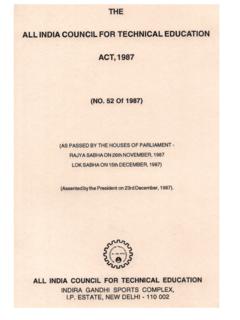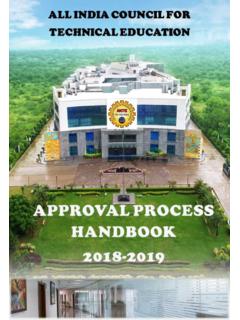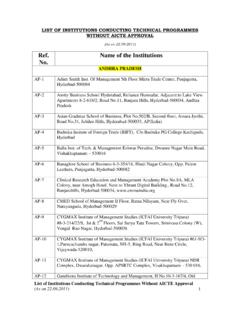Transcription of ALL INDIA COUNCIL FOR TECHNICAL EDUCATION
1 1 | P a g eANNEXURE IIALL INDIA COUNCIL FOR TECHNICAL EDUCATION7 THFLOOR, CHANDERLOK BUILDINGJANPATH, NEW DELHI 110 Skill Qualification Framework (NSQF)Introduction Recognizing the high demand for skill in the country, Central Advisory Board of EDUCATION (CABE) emphasized the need for a National Vocational EDUCATION Qualification Framework (NVEQF) that provides a common reference framework for linking various vocational qualifications and setting common principles and guidelines for a nationally recognized qualification system and standards. In pursuance of the decision of the Cabinet Committee on Skill Development in its meeting held on 19th December 2013, Ministry of Finance vide notification No. 8/6/2013-Invt. dated 27th December 2013 notified the National Skill Qualification Framework (NSQF).
2 As per the notification all other framework including NVEQF would cease to exist and will be superseded by NSQFIn view of the new notification by the by Ministry of Finance. The COUNCIL decided to run the existing programmes approved under NVEQF by AICTE after aligning them as per the provisions of 80 percent of new entrants to the workforce have no opportunity for skill training. Against approximately 15 million per annum new entrants to the workforce, the existing training capacity is approximately 3 million per annum. Additionally a large number close to 200 Million at IX, X, XI, XII drop out who need Vocational skills to be employable. This number is likely to be 500 Million by 2020. Mere skill building is not widely accepted within the society Mere Acquiring degrees or Diplomas does not guarantee jobs.
3 Hence a new paradigm is required to build skills and EDUCATION together for multiple pathways and multipoint entry exit Scenario Water tight educational entry and exit levels Increasing drop outs Social non acceptance to Vocational EDUCATION as an alternate to higher EDUCATION . 2 | P a g e Loss of productive youth Over qualified youth and non availability of appropriate jobs. Mismatch between Qualifications and Industry needs. Need to provide seamless integration between Vocational EDUCATION and Regular Higher EDUCATION Enhancement in GER Need to Enhance employability potentialObjectives Bridge skill gap and provide trained manpower to various emerging service sectors in INDIA Strive towards development of skilled manpower for diversified sector through short term, structured job oriented Courses.
4 Prepare the youth for a vocation of their choice; Build a formidable work force of international quality for Demand not only in INDIA but also in all other countries. Reduce unemployment by supplying world-class skilled people. Reduce cost and improve productivity of services and manufacturing by providing skilled manpower to international standardsPrinciples adopted for NSQFL ocalised approach Maximum Impact skills and sectors selected Subsidized Fee Structure to provide accessibility Skills for Women (Hair Dressing, Beauty Therapy, Teaching, Driving, etc.) Centrally administered Train The Trainers Placement assistance connecting candidates to jobs Building pathway for international progression. Recognition of prior learningFeatures of NSQF Across sectors and across the country Short duration, focused and modular programs Practical hands on focus Delivery in the local language Full day, half day or week end programs A network of centres Full mobility between formal, Vocational streams of EDUCATION and the Job market with multi Point Entry and Exit3 | P a g eOperational Methodology: Integrating VE with & Conventional EDUCATION Skill Knowledge Providers / Trainers (SKP) to be registered by AICTE or other authorised bodies for imparting specific skills.
5 A student registers with an AICTE approved TECHNICAL Institute or any other college for a Vocational Diploma or a Vocational Degree or registers with any other Institute affiliated to any TECHNICAL Board or a University. The student completes the skill modules as required at various certification levels, one level at a time, acquires the necessary credits from the Skill Knowledge Provider/Trainers (SKP), and gives them on to the Institute where he is registered for a Diploma, Post Diploma or a Degree. These credits are transferred to the TECHNICAL Board or the University as the case may be, which compiles the Vocational Skill credits and the formal EDUCATION credits and if all such credits are available as required by the certification level, then the TECHNICAL Board or the University shall award the certification at that level.
6 Certification levels as required will entail the student for the award of a Vocational Degree or a Vocational Diploma or a Vocational Post Diploma. The candidates may enter the job market after each certification level or may continue to acquire additional credits in part time / full time mode in order to complete the requirements of Vocational Diploma, Post Diploma or a Vocational Degree. In all seven certification levels of Knowledge and Skill have been identified. First two levels refer to standard IX and X at school level. These shall be with the CBSE schools or schools affiliated to State Boards and equivalent other boards. Each level requires 1000 hours of EDUCATION and training per annum. For the vocational stream leading to a Degree or a Diploma or a Post Diploma, these hours shall have both vocational and academic component.
7 The vocational component will go on increasing as the level of certification increases. The Skill modules or the Vocational content at a certification level could be a single skill or a group of skills of the number of hours prescribed. A candidate shall have freedom to choose either a vocational stream or a conventional stream to reach graduation level. In addition, a candidates shall have freedom to move from vocational stream to current formal higher EDUCATION stream or vice versa at various stages. This multi level entry and exit system shall allow the candidate to seek employment after any level and rejoin the EDUCATION as and when feasible to upgrade qualifications / skill competency. A student entering a Vocational stream from general stream can enter at a certain level provided the skills required at that level are acquired, from a registered SKP4 | P a g e A student who has acquired the skills through work experience, can also enter the Vocational stream at an appropriate level provided he is assessed for the skills acquired from a registered SKP The qualification frame work with upward mobility is shown as under.
8 Duration and Entry Level Qualifications under the frameworkCase 1 Case IICertification LevelNormal QualificationVocational QualificationCertifying BodyVocational QualificationCertifying Body1 Secondary School Grade IXGrade IX (Vocational)SchoolGrade IX (Vocational)School2 Secondary School Grade XGrade X (Vocational)SchoolGrade X (Vocational)School3 Higher Secondary School Grade XIDiploma (Vocational)Board of TECHNICAL EducationGrade XI (Vocational)School4 Higher Secondary School Grade XIIG rade XII (Vocational)School51styr bachelorsDegree (Vocational)University62ndyr bachelorsAdvanced Diploma (Vocational)Board of TECHNICAL Education73rdyr bachelors5 | P a g eSuggested Credits: QualificationEquivalenceSkill certification LevelCompetency based Vocational skill Building (in Hrs) (approximate)General learning (in Hrs.)
9 (approximate)Total (Vocational)XI (Vocational)34006001000 XII (Vocational)XII (Vocational)44505501000 Year IDiploma (Vocational)Degree (Vocational)55504501000 Year IIAdvanced Diploma (Vocational)Degree (Vocational)66004001000 Year IIIA dvanced Diploma (Vocational)Degree (Vocational)77502501000 Pathways in NSQF:6 | P a g eCommunity College Courses in Existing PolytechnicsIntroduction There are more than 3500 polytechnics and equivalent TECHNICAL institutions which have potential to provide skill training to millions of youth through their own facilities and or by establishing extension centres in collaboration with ITIs, or Vocational Skill Knowledge providers, NGOs, and other colleges in the Arts Science and Commerce streams. These polytechnics can also render useful services in adoption of appropriate technologies and providing TECHNICAL and support services to rural people and slum approved polytechnics are considered to be a viable vehicle for providing the intended services as mentioned rationale for choosing AICTE approved Polytechnics for the implementation of Scheme of Community Development through Polytechnics is based on the fact that AICTE approved Polytechnics are equipped with the following type of resources: Polytechnics are equipped with physical facilities in the form of buildings, lecture halls, laboratories, workshops, hostels etc.
10 Which could be used as Knowledge and Skill Centres for rural community and slums dwellers; Polytechnics have qualified and trained faculty who can scientifically formulate, implement and monitor community oriented programs and projects especially where the activity of adoption of appropriate technology is involved; Polytechnics have technicians and craftsmen whose services can be utilized to some extent for imparting skill training and adoption of appropriate of Polytechnics could be of tremendous help in making meaningful contribution to community and rural development. Polytechnics can, therefore, render vital assistance in the community development work. This, they can do partly by utilizing their own resources and partly by mobilizing the resources available at the higher technological institutions.















